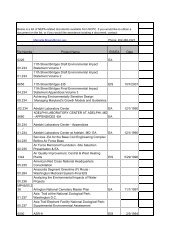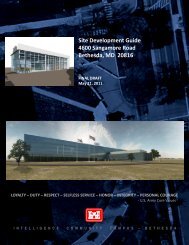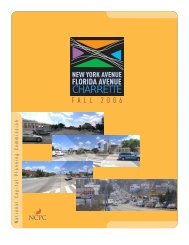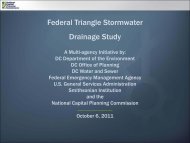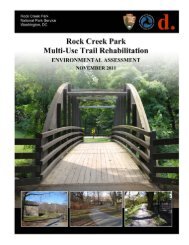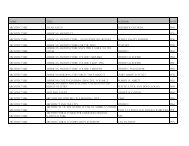Tetratech Interior Drainage Study for Potomac Park - National ...
Tetratech Interior Drainage Study for Potomac Park - National ...
Tetratech Interior Drainage Study for Potomac Park - National ...
Create successful ePaper yourself
Turn your PDF publications into a flip-book with our unique Google optimized e-Paper software.
MEMORANDUMThe Federal Triangle is at the bottom of a watershed that extends north to Buchanan Street NW and isshown on Figure 2. This watershed is approximately 5.2 square miles. The <strong>Potomac</strong> <strong>Park</strong> levee itself isoutside of this watershed and is located such that very little overland flow is generated in the drainagearea directly tributary to the levee. This levee watershed is also shown in Figure 2. Note in Figure 2 thatthe watershed boundary separating the Federal Triangle and <strong>Potomac</strong> <strong>Park</strong> basins is not governed entirelyby the topographic contour lines because the subsurface storm drainage system handles a portion of floodrunoff.The Federal Triangle area is served by a partially separated sewer system. The combined system is partof a large and complex sewer system that serves the combined and separate sewered areas in the Districtof Columbia and portions of the separately sewered areas Maryland and Virginia. The combined systemis operated by the District of Columbia Water and Sewer Authority (DC WASA). The Federal Trianglearea is part of the B Street / New Jersey (NJ) Avenue system. This system includes a network of pipeswhich terminate in the O Street and Main Pumping Stations. The O Street Pump Station provides theprimary service <strong>for</strong> the Federal Triangle area. These pump stations handle combined sewage during largestorms. The Federal Triangle area is also drained by a storm drain that drains by gravity to the TidalBasin and then into the <strong>Potomac</strong> River.The O Street and Main Pumping Stations serve an area much greater than the Federal Triangle. The MainPumping Station serves the entire area in the northeast and southeast portions of the District. Flows areconveyed to the pump station primarily by the B Street / NJ Avenue Trunk Sewer, the Tiber Creek TrunkSewer and the East Side Interceptor. The O Street Pumping Station which is adjacent to the MainPumping Station can be considered a supplement to the Main Pumping Station (O&M Manual, 1993).Overflow from both pump stations is discharged to the Anacostia River. The operation and maintenancemanual <strong>for</strong> these pump stations (included in Appendix B) indicates that the main purpose of the pumpstations is to prevent sewage from entering the river by pumping it to the Blue Plains WastewaterTreatment Plant. Each pump station includes sanitary and stormwater pumps. The effect of the pumps onthe Federal Triangle area is dependent on the amount of flow that is being conveyed to the pumps fromthe other service areas.Previous <strong>Study</strong>In 1992 the U.S. Army Corps of Engineers (Corps) developed a General Design Memorandum <strong>for</strong> theModifications to Washington D.C. and Vicinity Flood Protection Project. As part of that report aninterior drainage analysis was prepared to document the residual flooding in the interior area. Thisanalysis focused on the effects from local rainfall and states that because the storm sewer capacity is afunction of pumping capacity, the stage of the river has little impact on the interior pond elevation. Aconclusion of the report is that the project will not worsen interior flooding in most areas.While no significant changes in the WASA sewer system have occurred since the Corps study wascompleted, new topography has become available. Much of the methodology used by the Corps is similarto what is reflected in this updated study.The final interior ponding area identified in this report is shown on the figures associated with theanalyses per<strong>for</strong>med <strong>for</strong> this current study. The significant area of ponding in the Corps’ analysis isidentified as Pond IA. The pond elevation associated with the 100-year rainfall in Pond IA is 10.76 feetNGVD29 (approximately 10 feet NAVD88).2



